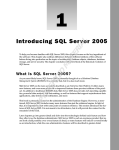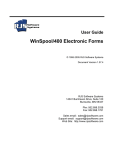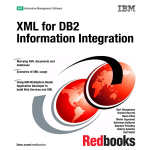Download Wiley Microsoft Access Data Analysis: Unleashing the Analytical Power of Access
Transcript
CHAPTER 1 D MA TE RI AL Access Basics PY RI GH TE When working with Access for the first time, it is tempting to start filling tables right away and querying data to get fast results, but it is important to understand the basics of the relational database concept before pounding away at data. A good understanding of how a relational database works will help you take full advantage of Access as a powerful data analysis solution. This chapter covers the fundamentals of Access and methods to bring data into the program. CO Access Table Basics Upon opening Access, you notice that the Database window, shown in Figure 1-1, has seven sections. Each section represents one of the seven database objects: tables, queries, forms, reports, pages, macros, and modules. The “Tables” selection is at the top of the list, because it is the precise location where your data will be stored. All other database objects will refer to the Access tables for data, whether asking questions of the data or creating reports based on the data. This section covers the basics to get you working with Access tables immediately. 3 4 Chapter 1 Figure 1-1 The Database window has seven main sections you can work with: Tables, Queries, Forms, Reports, Pages, Macros, and Modules. What is a table? One way to think of a table is as a collection of data concerning a specific entity (for example, customers, branches, transactions, products, and so on). You want each of these entities to have its own unique table. Among the many advantages to storing your data using this approach is eliminating or significantly decreasing duplicate information. Later in the chapter, you learn about the dangers inherent in storing data with excessive duplications. Opening a table in Datasheet view Open your sample database, click the Tables section (highlighted in Figure 1-1), and then double-click the CustomerMaster table. When the table opens, it is in the Datasheet view. In this view, you are able to directly view and edit the contents of the table. As you can see in Figure 1-2, the names of the columns are at the top. Identifying important table elements Access tables consist of rows, with each row representing a single instance of the table name or entity. In CustomerMaster, each row represents a single distinct customer with which the firm does business. In proper database terminology, a row is called a record. The table also comprises columns, with each column representing a particular piece of information common to all instances of the table’s entity. In CustomerMaster, each column represents some attribute of the customer that you want to record. In proper database terminology, a column is known as a field. Access Basics Figure 1-2 Opening the table in Datasheet view allows you to view and edit the data stored in the table. T I P The number of records in a table is visible at the bottom left of the Datasheet view, next to the record selectors. Opening a table in Design view Through the Design view of a table, you are able to set the field names and data types. To get to the Design view of the CustomerMaster table, right-click the CustomerMaster table and select Design View. As you can see in Figure 1-3, the Design view shows you the fields that comprise the CustomerMaster table in an easy-to-manage view. Note how each field has a field name and a data type. Data types are discussed later in this chapter. The field name is the descriptive text string given to a particular column of a table. It is what appears at the top of the table when it is in the Datasheet view. Follow these guidelines when naming your fields: ■■ The maximum length of a field name is 64 characters. ■■ Your field name cannot include a period (.), an exclamation point (!), an accent grave (`), or brackets ([ ]). ■■ You can begin your field name with leading spaces. T I P It is good practice not to put any spaces in your field names. When constructing queries or referring to tables in VBA code, spaces in the field names can lead to problems. If you need to indicate a space in your field name, use the underscore character. 5 6 Chapter 1 Figure 1-3 Opening the table in Design view allows you to add field names or change existing ones. Exploring data types The field’s data type ensures that only a certain type of data is allowed in the field. If a data type is tagged as a number, Access will not allow any text to be entered into that field. By setting the data type of each column, you go a long way toward ensuring the integrity and consistency of the data. The concept of the data type is crucial to not only understanding Access, but also to unlocking the power of the programming language behind Access, VBA. Quite simply, computers process and store data and that data is categorized by its type. With the CustomerMaster table left open in Design view, place your cursor in the Data Type section of the first field and click the drop-down arrow shown in Figure 1-3. A list of predefined data type choices becomes visible. These data types are Text, Memo, Number, Date/Time, Currency, AutoNumber, Yes/No, OLE Object, and Hyperlink. The following sections describe these data types in more detail. Text Any combination of letters, numbers, spaces, and characters is considered Text. This is by far the most common data type. Although Text can be a number, it should not be a number used in a calculation. Examples of the Text data type are customer names, customer numbers (using customer numbers in calculations would have no meaning), and addresses. The maximum number of characters allowed in a Text field is 255. Access Basics Memo If you need to store text data that exceeds the 255-character limit of the Text field, you should use the Memo field. Long descriptions or notes about the record can be stored in fields of this type. Number The Number type is used for all numerical data that will be used in calculations, except money or currency (which has its own data type). Actually, Number is several data types under one heading. When Number has been selected as a data type in the Design view of the table, go to the Field Size field at the top of the General tab. When you select the down arrow, you get the following options: Byte, Integer, Long Integer, Single, Double, Replication ID, and Decimal. Probably the most common field sizes of the Number data type are Long Integer and Double. Long Integer should be selected if the numbers are whole numbers that do not have any non-zeros to the right of the decimal point. Double should be selected if decimal numbers need to be stored in that field. Date/Time Another data type often used in calculations is Date/Time. Recording the time that certain events occurred is among the more important uses of this data type. Recording dates and times allows you to compare data by time durations, be it months, years, or whatever. In the business world, the Date field can be crucial to analysis, especially when identifying seasonal trends or making year over year comparisons. Currency Currency is a special calculation data type, ideal for storing all data that represents amounts of money. AutoNumber This data type is actually a Long Integer that is automatically and sequentially created for each new record added to a table. The AutoNumber can be one mechanism by which you can uniquely identify each individual record in a table. You will not enter data into this field. Yes/No In some situations, the data that needs to be represented is in a simple Yes/No format. Although you could use the Text data type for creating a True/False field, it is much more intuitive to use Access’s native data type for this purpose. 7 8 Chapter 1 OLE Object This data type is not encountered very often in data analysis. It is used when the field must store a binary file, such as a picture or sound file. Hyperlink When you need to store an address to a Web site, this is the preferred data type. Preparing to create a table Before you start creating a table, you need to answer the following questions: ■■ What is the name of the table? What is the entity for which you would like to collect and store data? ■■ What are the names and types of columns or fields? Which attributes of this particular entity do you need to record/store? What are the appropriate data types of these fields? ■■ How can you identify each instance of the entity uniquely? Keep in mind that to take full advantage of Access, you may have to split data that was previously stored in one large dataset into separate tables. For example, think of a flat-file list of invoice details in Excel. Typically, this list would repeat Invoice Header information for each individual detail of that invoice. In order to eliminate as much of the duplicate data as possible, you would divide the single list into two logical parts: InvoiceHeaders and InvoiceDetails. Each unique Invoice will be listed only once in the InvoiceHeaders table. All of the details for that invoice will be in the InvoiceDetails table. Given this structure, Access will be able to recognize a relationship between the two tables. Different methods for creating a table Access provides different methods for creating a table. You can, for example, use the Datasheet view, the Design view, or the Table Wizard. For users new to Access, the Table Wizard provides an excellent opportunity to walk through the process. Tables are also created automatically when you import data from an outside source, such as an Excel spreadsheet. An Access table can also be a link to a table outside of the database. Importing and linking are covered later in this chapter. Access Basics If you are neither importing nor linking data, the ideal way to create a table in Access is with the Design view. You looked at the Design view previously and saw that it is essentially a list of columns and data types in the table. Here you can enter the names of every column and its matching data type. Creating a table with Design view Imagine that a company’s human resources department asks you to create a simple list of employees in Access. To create a table in Design view, select Insert → Table. This opens the New Table dialog box shown in Figure 1-4. You must now create a list of attributes, or fields, that describe each employee in a particular way. Among the more common attributes in this situation are the following: EmployeeNumber, FirstName, LastName, Address, City, State, Zip, and HourlyWage. You begin by entering the names of the columns going down the list. Default data type As you enter the field names, you may notice that the data type defaulted to the most common data type, Text. You now want to set the data types for each field, or at least change the data type of each non-text field. Choosing the correct data type for the first field, EmployeeNumber, may be initially confusing. With the word “Number” in the field, you might think that Number would be the logical choice for the data type. Actually, the rule of thumb is that if the field will not be used in a calculation, it is best to set its data type to Text. There is no logical meaning to performing calculations on the EmployeeNumber field. It is highly unlikely that adding two values from this column would give you information of any significance. Another reason for using the Text data type in the EmployeeNumber field is that there could be alpha characters or letters in the field. Data types for calculations The field names for this particular table should make it fairly obvious that you will want to set all of the fields to Text, except when it comes to HourlyWage. This field will almost certainly be used in calculations. For example, multiplying an employee’s hourly wage by 40 will get you his or her weekly salary. So, because this field will certainly be used in calculations, and because it will represent a monetary value, you should change the data type to Currency. At this point, your Design view should look similar to the screen shown in Figure 1-5. 9 10 Chapter 1 Figure 1-4 Open the New Table dialog box and double-click Design View. Now you can save and name your table by selecting File → Save. Give the table an appropriate name, such as “Employees” or “EmployeeMaster.” Keep in mind that at this point, this table contains no data. You can start entering employee information directly into the table through the Datasheet view. If you have a table with a small number of records, you can enter your records manually. However, most sets of data are quite large, so other techniques of bringing data into Access are covered later in the chapter. Figure 1-5 After entering the field name, the data type defaults to Text. Access Basics Tricks of the Trade: Working with the Field Builder A great tool for beginning Access users is the Field Builder. It works as a wizard to help you build your table and also gives you practice selecting data types. In the Design view, select the column for which you would like to build a field and click the Build button on the toolbar. In Figure 1-6, you can see what the Field Builder looks like. Figure 1-6 The Field Builder utility can help you build your table with just a few clicks of the mouse. The Field Builder provides a collection of sample tables, each with their own sample fields. It is very likely that you will find a field equivalent to what you would like to create in this list. When you select a field, not only will the name of the field be added to the Design view of the table, but the suggested data type will be added for you as well. This can be a great way to teach yourself about data types. Simply create a dummy table and choose the fields that interest you or that you might potentially need in the future. Then, after selecting each item, check to see what data type was automatically populated in the list. Look at different Number fields and pay attention to different settings for the Field Size in the Number data type. Advanced Table Concepts Now that you can create a table and manually enter data into it, this section turns to more advanced table concepts. When working with data in tables, you may encounter situations in which you want to restrict or default data that is entered in particular columns. There is also the question of being able to uniquely identify each record in any given table. 11 12 Chapter 1 Field properties After entering field names, data types, and descriptions, you can set individual field properties for each column, which will affect how the data is stored and presented, among other things. The list of field properties is dependent on the data type chosen for that field. Some field properties are specific to Text fields, and others are specific to Number fields. The field properties are located in the Design view of a table on the General tab at the lower left. The following sections cover the more important ones. N OT E Note that the properties shown on the General tab change to reflect the data type you choose. Field Size You encountered Field Size before, when working with the Number data type. This property also exists for the common Text data type. This property allows you to set a maximum size limit on data entered in that column. For the Text data type, size refers to the length (number of characters and spaces) of the Text data in that column. For example, if you look at the Employees table, you see a field for State. Your company tells you that the names of states should be recorded using their two-letter designation. If you therefore set the field size to “2” for the State column, the user will be unable to type any text longer than two characters. So with Access, you are not only able to force a certain data type in a particular column, but you can also customize that individual column to accept data only in the rigid format that you specify. Format The Format property enables you to customize the way numbers, dates, times, and text are displayed and printed. As with the Field Size property, the format available for selection will depend on the data type of that column. For example, with a Currency field, you can display the data in a form that uses a dollar sign, or a Euro sign, or no sign at all. The data itself will not be changed with these settings, just how the data is displayed. Format is especially useful when it comes to Date/Time data types. Whether you want to display data in the long format or short format, this property allows you to set that option. Access Basics USING THE INPUT MASK WIZARD There is an extremely helpful tool called the Input Mask Wizard. To call this wizard, place your cursor inside the field for which you need an input mask. This will make visible a button with the ellipsis dots (...). Click the newly visible button to activate the Input Mask Wizard. The wizard provides the most common examples of Input Masks and even allows you to test their behavior. Figure 1-7 shows the Input Mask Wizard. Figure 1-7 The Input Mask Wizard enables you to specify the structure of data being entered into a field. Input Mask The Input Mask property can be useful in data entry situations. Whereas Format controls how data is displayed, Input Mask controls how data is entered into a particular field. Input Mask is available for the following data types: Text, Number, Date/Time, and Currency. For example, if a user needs to enter a telephone number, Input Mask can create the characters and structure with which everyone is familiar. As the user types, the number automatically assumes a phone number format: (###) ###-####. Decimal Places In number fields, you can set the number of decimal places that will be recorded to the right of the decimal point. There is an Auto setting, which will defer to the Format setting to determine the correct number of places. Apart from Auto, you are able to select 0 to 15 for the number of decimal places. 13 14 Chapter 1 Default Value An important database concept, Default Value can help save time in the data entry process. The default value is automatically placed in a column every time a new record is added. Defaults can be overridden, so your column is not forced to have only that particular value. Required Another important property, Required simply forces a user to enter some value, using the proper data type, in the designated field. A new record will not be added if the Required field is not properly filled. As with Input Mask, this property is an excellent mechanism for asserting more control over the data entry process. Primary key You will recall that earlier in the chapter, you needed to ask yourself three questions to determine just how a new table was to be created. The third question specified that you need a way to identify or reference every record. In other words, there needs to be some unique text or number column that will have no duplicate values, in much the same way that Social Security numbers uniquely identify individuals. Each person has one and only one Social Security number. By definition, you cannot have a Social Security number that represents two people. This unique column is known as a primary key and it is the mechanism by which you relate different tables to each other. To set the primary key, right-click the field that could be a primary key candidate and select Primary Key. At this point, Access will automatically determine if that particular field contains duplicate data—that is, data items that exist in more than one row. If there are duplicates, Access informs you with an error message. You must remove any duplicates if that column is indeed to become the primary key for the table. T I P Access provides its own automatic primary key with the AutoNumber data type. The AutoNumber simply increments one for each record added, so there will be no duplicates. However, it is preferable to use actual data for a primary key and not just some number that indicates the record’s position in a table. If every employee has a unique employee number, that field would be an ideal primary key. If you have a situation where there is no unique single column, consider using a combination of columns that together make up a unique record. You can set multiple columns to be the primary key; this is called a Compound Key. It has the effect of combining separate columns to represent a single, unique value. Access Basics Tricks of the Trade: Sorting and Filtering for On-the-fly Analysis There is inherent functionality within Access that can assist you in performing quick, impromptu data analysis. SORTING It is significantly safer to sort data in an Access table than in an Excel spreadsheet. One of the potential problems with sorting data in Excel has to do with the free-form nature of a spreadsheet, which allows you to inadvertently sort only one column in your dataset. With Access, you do not have to worry about the impact on presentation when you sort. The data is separate from the presentation. Open up a table in the Datasheet view and select the column you want to sort. That is, click the gray box with the column name once. This action should highlight the entire column. Once your column is highlighted, right-click and then select Sort Ascending or Sort Descending from the popup menu shown in Figure 1-8. Figure 1-8 From the right-click menu, you can choose to sort a column in ascending or descending order. FILTERING Another extremely useful table function is Filter By Selection and Filter Excluding Selection. The idea behind these filters is that you will click a single data value in a record. Choosing Filter By Selection then hides all records that do not have that particular value in that particular column. This can be an excellent method to perform fast analysis. Suppose you have a list of employees and you want to quickly know how many are in California. Find a record—any record—whose state is California, then click in the State column of that record. After filtering by selection, only records with California as the state will be visible. The non-California records are not deleted; they are just temporarily hidden by the filter. continues 15 16 Chapter 1 To demonstrate this functionality in action, open the CustomerMaster table and right-click in the State column. The popup menu shown in Figure 1-9 activates. Type CA in the Filter For text field to filter only those customers based in California. Figure 1-9 The Filter For functionality allows you to filter your data on-the-fly. You can easily remove the filter and restore the table to its natural state by clicking the following: Records → Remove Filter/Sort. Another useful filter works in the opposite manner. The Filter Excluding Selection hides all records that have the same value in the column that you clicked. Going back to our example, if a user selects a record with California as its state, the Filter Excluding Selection hides all records where the state is California. All records with that data value have been temporarily hidden from view. Getting Data into Access Now that you have learned basic and advanced table concepts, you are ready to bring data from outside sources into Access. Apart from creating a table from scratch and manually entering the data, the two main methods for bringing data into Access are importing and linking. Access Basics Importing With importing, you are making a copy of the data and filling a newly created table with the copied data. After importing, the data is disconnected from the source from which it was imported. If any future changes are made to the outside source, they will not be reflected in the Access data. This is true in the other direction, in that changes to your Access data will not affect the original source. After importing a table, it is common to treat that Access data as the true data source. Any updating, appending, or deleting will be done to the Access data. Then, when it is time to analyze the data, you can be sure it reflects the latest, most accurate version of that data. Linking When you link a table to Access, you are creating a pointer to another data source. When the Access database is opened, it establishes links to its outside data source and displays the data as if it were a regular local Access table. However, there is no data residing in Access. The data is physically located on another computer, server, or source. If you change the data in the Access table, the true data source will reflect that change. If you change the original data source, those changes will be reflected when you reopen the linked table. Things to remember about importing data Your decision whether to import or link data depends on the situation. When you import data, it resides directly in the Access file, so operations on that data perform much faster. With linked tables, you may be dependent on the speed of the connection with the data source or the speed of the database engine at the other end. One important point to remember is that when importing data, you can select to create a new table or import your data into an existing table. If you choose to create a new table, Access makes a copy of the data to import, then attempts to determine the column names and field data types. Access may make an incorrect assumption about the data type, but you can go back and make the necessary changes. If you choose to import data to an existing table, you must make sure that the data types of the fields are compatible. If you attempt to import a text string into a number field, for example, an error will occur. 17 18 Chapter 1 WAR N I N G It is important to remember that Access does not let go of disk space on its own. This means that as time goes on, all the file space taken up by the data you imported will be held by your Access file, regardless of whether or not the data is still there. With that in mind, it is critical that you “compact and repair” your Access database regularly to ensure that your database does not grow to an unmanageable size, or even worse, become corrupted. To compact and repair your database, simply select Tools → Database Utilities → Compact and Repair Database. Importing data from Excel spreadsheets You can import data from a wide variety of sources into Access tables: Excel spreadsheets, text files, or another database table. Access provides a set of easy-to-use Import wizards, such as the one illustrated in Figure 1-10, that guide you through the process of importing data. If you are importing a properly formatted Excel flat file, the wizard prompts you to ask if the top line is the location of the column names. Another extremely useful feature of this wizard is that it lets you select a column to serve as the primary key of the table or it will add an AutoNumber primary key. If you select a column to serve as the primary key, the wizard performs a test on the column to ensure against duplicate values. If duplicate values exist in that column, the wizard informs you that it cannot set that column as the primary key and the table is imported anyway. Figure 1-10 The Import Spreadsheet Wizard displays sample data from the worksheet selected in the display. Access Basics T I P The Import Spreadsheet Wizard attempts to make an educated guess as to what data type to set for each column. Still, it is a good idea to check the data type of each column after importing the data, because you may need to make some changes. Importing data from text files Similar to importing data from spreadsheets, the data in text files must be in a consistent format in order for the wizard to extract the information correctly. Typically, the data in text files is delimited (separated) by commas. Access will properly interpret this and separate the data located between the commas into their appropriate fields. Usually someone in I.T. will prepare a text file of data for the analyst, or it can be an output of a mainframe application. The Relational Database Concept A relational database is a database that is structured around shared attributes between two or more datasets. In a relational database, data is stored in tables based on logical characteristics to minimize redundancy and to improve data integrity. Access is a relational database. If you want to understand just how Access works, you need to understand the relational database concept. Excel and the flat-file format The term flat file is used to describe a single table that has a two-dimensional structure consisting of rows and columns. Although flat files are generally easy to use and understand, they contain lots of redundant data and virtually no inherent mechanisms to protect data integrity. When you are working with data in an Excel file, you are working with a flat file. Some data analysis scenarios are not terribly complex, which means that a flat-file representation of the data to be analyzed is adequate. However, most data-analysis scenarios require analyzing data that is much more multidimensional. One of the main reasons the flat file can prove inadequate is that it is two-dimensional. Real-world business data rarely falls into a convenient, two-dimensional format. Of course, it can be forced into that format by the Excel guru who wants all analysis to fit into the spreadsheet. Take a look at a typical example of a flat file. Figure 1-11 shows a typical flat-file list of invoices. 19 20 Chapter 1 Figure 1-11 Data is usually stored in an Excel spreadsheet using the flat-file format. In order to get the customer information for each invoice, several fields exist for customer-specific information: customer name, address, city, and so on. Because most firms sell to customers more than once, you can see that customer information is often repeated. Duplicate information is one of the main drawbacks of the flat-file format. What is wrong with duplicate data? Initially, the duplicate data may not appear to be a potential source of future problems, but upon further examination, you discover the shortcomings. First is file size. Duplicate data wastes space, both on the computer hard drive, where the file is stored, and in the computer’s memory, where the data resides when it is being operated on. Although the enormous amounts of memory that are standard with today’s machines go a long way toward handling excessive demands, having duplicate data wastes valuable computer space and resources. The duplicate information is not valuable to us. In fact, it leads to problems, particularly when data needs to be updated. As you can see in Figure 1-11, a number of different invoices have been recorded for CORRUL Corp. You can also see that the information for CORRUL Corp. is repeated for every invoice. What if CORRUL Corp.’s customer information changes, though? What if it acquires new office space and you want to reflect this change of location in your data? You would have to update the change in several different places, ensuring that every invoice correctly maps back to its relevant customer information. Although excellent functions are available that can find and replace data in Excel, there is still a danger that you might not make all of the updates correctly. Whenever you are changing the same, duplicate information, the risk of introducing unintentional errors is always present. This could significantly affect your data analysis. For example, suppose that CORRUL Corp. moved to a different city. Figure 1-12 demonstrates how easy it is to incorrectly update the data. Access Basics Figure 1-12 The last record of CORRUL Corp. was not correctly updated to the new address. If the City data is not properly updated everywhere, when you attempt a by city filter/analysis, you will not get accurate results. Some of the invoice records could reflect the incorrect state locations of the customer. The attributes of data can and often do change, and if these changes are not accurately recorded, your data analysis will provide an incorrect picture of the actual situation. Splitting data into separate tables Data must be consistent if analysis is to have any true value in the decisionmaking process. Duplicate data is the bane of consistent data. If an entity is changed in one place, it must be changed everywhere. Wouldn’t it be more logical and efficient to record the name and information of a customer only once? Instead of recording the same customer information repeatedly, you could simply have some form of customer reference number, which could then send you to another list where the information is unique and written once. This brings us back to the relational database concept, which enables you to have separate, carefully designed unique lists of data that are related to one another by their unique identifiers (primary key). Many Excel users, in fact, without realizing it, make great efforts to make the data on their spreadsheets “relational.” For example, the use (or overuse) of the VLOOKUP or HLOOKUP helps you match data from separate lists that have some data field or key in common. Although much is possible with these functions, they do have their limitations. Furthermore, the functions are not very intuitive. They attempt to solve a problem that Access was designed from the ground up to address. When Excel users use these functions to bring data from separate lists onto a single row, they are in essence creating a relationship 21 22 Chapter 1 of that data. The problem is that the data has not really been related; it has simply been shown how it could relate to each other on a particular spreadsheet tab. A different tab may choose to “relate” the data in a completely different way. The problem for the analyst is that if there were relationships between the data that were consistent or even permanent, it would be easier to somehow reflect them in a behind-the-scenes representation of the data. Some of the data relationships can be quite complex, and if the analyst is forced to remember and manually enforce all of them, analysis is detracted from and the possibility of mistakes increased. Foreign key To set relationships between tables, you take a primary key field from one table and use it to relate that entity to records in another table. When the primary key is used in a different table in order to establish relationships, it is called a foreign key. In the TransactionMaster table, for example, you see a Customer_Number field. This is the same primary key field from the CustomerMaster table. Relationship types Three types of relationships can be set in a relational database: ■■ One-to-one relationship. For each record in one table, there is one and only one matching record in a different table. It is as if two tables have the exact same primary key. Typically, data from different tables in a one-to-one relationship will be combined into one table. ■■ One-to-many relationship. For each record in a table, there may be zero, one, or many records matching in a separate table. For example, if you have an invoice header table related to an invoice detail table, and the invoice header table uses Invoice Number as the primary key, the invoice detail will use the Invoice Number for every record representing a detail of that particular invoice. This is certainly the most common type of relationship you will encounter. ■■ Many-to-many relationship. Used decidedly less often, this type of relationship cannot be defined in Access without the use of a mapping table. This relationship states that records in both tables can have any number of matching records in the other table. In the sample database, relationships have already been established between the tables. Take a look at some of these relationships in order to get a better idea of how they can be set and changed. In the Tools menu, select Relationships so you can view the relationships that have already been set. As shown in Figure 1-13, the lines between the tables signify the relationships. Access Basics Figure 1-13 A one-to-many relationship between tables can be identified by the infinity symbol on the line connecting the tables. Creating and editing relationships In the Relationships window, you can add tables by right-clicking the display and selecting Show Table. Once your tables have been added, relationships can be established by dragging one field from one table to a field in another table. Figure 1-14 shows the Edit Relationships dialog box that then appears. You can also edit an existing relationship by right-clicking the line connecting the two tables. Figure 1-14 Based on the use of primary keys and foreign keys, the Edit Relationships dialog box attempts to guess the kind of relationship you want to establish. 23 24 Chapter 1 Referential integrity In addition to establishing relationships between tables, you are able to enforce certain rules that guide these relationships. For example, if you have an Invoice table with a Customer_Number foreign key, you will not be able to add an invoice for a customer number that does not exist in the other table. You must add the new customer to the customer table before the new foreign key can be placed in the invoice table. Also, if you attempt to delete a customer from a table when there are matching invoices for that customer, an error will occur. Referential integrity allows you to use Access to maintain the relationships that you have created. By clicking the Enforce Referential Integrity checkbox in the Edit Relationships dialog box, you tell Access to first verify that a valid relationship exists between the two tables. Here are some conditions that need to be met to establish referential integrity: ■■ The field that is used to match the two tables must be a primary key in one of those tables. ■■ The field that is used to match the two tables must be of the same data type. Once the validity of the relationship has been established, referential integrity will be continuously enforced until switched off. Cascading updates and deletes The main purpose of referential integrity is two-fold: first, to prevent changing a primary key value for which there are matching foreign key values in a second table, and second, to prevent the deletion of a primary key value for which there are matching foreign key values. These two rules of referential integrity can be overridden by clicking either Cascade Update Related Fields or Cascade Delete Related Records. This topic is touched on again in Chapter 2. Query Basics Once the data is in Access and the relationships between the tables have been established, you are ready to start analyzing the data. As you can see on the Database window, “Queries” is the next main database object. This section focuses on perhaps the most common type of query: the select query. It also discusses the basic concept of the query and provides a few examples to illustrate just how easy they are to create in Access. Access Basics What is a query? By definition, a query is a question. For our purposes, it is a question about data, which is stored in tables. Queries can be exceedingly simple, like asking what all of the data in a table is. Queries can also be quite complex, testing for different criteria, sorting in certain orders, and performing calculations. In Access, two main types of queries exist: select and action queries. Select queries are perhaps the most common type. This query simply asks a question of the data and returns the results. No changes are made to the data whatsoever. You can always run select queries and never worry that the actual data is being altered. Action queries actually manipulate and change the data in a table. The action query can add records, delete records, or change information in existing records (updating). This type of query is discussed more fully in Chapter 2. N OT E Keep in mind that the results of a query are separate from the query itself. The query is simply the question, not the results of the question. If the data in the table is changed and the query is run again, you could get different results. The results of a query are not located in a separate table that exists in Access. The results come directly from the table that is being queried. You have separated the raw data from the questions that you would like to ask of it. Creating a select query Quite often, when you are working with or analyzing data, it is preferable to work with smaller sections of the data at a time. The tables contain all the records pertaining to a particular entity, but perhaps for your purposes you need to examine a subset of that data. Typically, the subsets are defined by categories or criteria. The select query enables you to determine exactly which records will be returned to you. If you thought that creating queries required learning a programming language or some other technological hurdle, that is not entirely accurate. Although it is possible to create queries using the programming language of databases—SQL—it is much more easy and intuitive to use the Query By Design (QBD). The Query By Design is a graphic user interface where the tables and columns are visually represented, making it easy to visualize the “question” you would like to ask of the data. 25 26 Chapter 1 The Query By Design interface Go to your sample database and select the Queries tab. At the top, double-click “Create query in Design view.” The Show Table dialog box opens, sitting on top of a blank Query By Design (QBD) interface, as shown in Figure 1-15. Some also call this the query grid or design grid. When creating your “question” of the data, the first thing you must determine is from which tables you need to retrieve data. The Show Table dialog box allows the user to select one or more tables. As you can see in Figure 1-15, there are also tabs for Queries and Both. One of the wonderful features of queries is that you are not limited to just querying directly off the table. You can create queries of other queries. For this first query, select the CustomerMaster table, either by selecting the table in the list and clicking Add or by double-clicking the table in the list. Now that you have selected the table from which you want to retrieve data, you must select the fields of that table that you would like to retrieve. The QBD is divided into two sections. The top half shows the tables or queries from which the query will retrieve data. The bottom half shows the fields from which the query will retrieve data. You can also add your own “calculation” fields that perform operations on other fields, and output the result. You will notice in Figure 1-16 that the CustomerMaster table at the top half of the QBD lists all the fields, but has an asterisk at the top of the list. The asterisk is the traditional database symbol, which means that all fields from that table will be in the output. Figure 1-15 The Show Table dialog allows you to select the tables or queries to which to add the Query By Design. Access Basics Figure 1-16 The Query By Design interface. For this example, select the following three fields: Branch_Num, Customer_Name, and State. To select fields from the top half of the QBD, you can either double-click the field or click it once and drag it down to the bottom half. Now that field will be included in the output of the query. Figure 1-17 shows you how the Query By Design should look after selecting the output fields. Running a query At this point, you have all you need to run the query. You can run a query from the QBE in two ways. Either select Query/Run or click the red exclamation point in the toolbar. As you can see from Figure 1-18, the output from a query looks similar to a regular table after it is open. Figure 1-17 The lower half of the Query By Design interface shows the output fields of the select query. 27 28 Chapter 1 Figure 1-18 The Datasheet view of query shows the results of the query. Sorting query results Here, you examine how you can sort the results of this query. Just as you sorted in Excel, you are going to select a column and choose between ascending sort and descending sort. In the bottom half of the QBD, you’ll notice the Sort row on the grid. This is where you can select either one or multiple sort columns. If you select multiple sort columns, the query sorts the results in order of left to right. Go to the State column and click your mouse on the Sort section. As shown in Figure 1-19, a down arrow appears, allowing you to select either Ascending or Descending for that particular column. Select Ascending and rerun the query. When you ran the query before, the states were in no particular order. After setting the sort order of the State column to ascending, the query output simply looks better and more professionally formatted, as shown in Figure 1-20. Access Basics Figure 1-19 The sort order options for a column are provided by the Query By Design interface. Figure 1-20 The results of the query are now sorted in ascending order by the State field. 29 30 Chapter 1 Filtering query results Next, you examine how you can filter the query output so that you retrieve only specific records to analyze. In Access, this filter is also called Criteria. You can see the Criteria section for each column added in your QBD. This is where you will enter the value, or values, for which you would like to query. When entering a value in the Criteria section, all records that match it are returned in the query output. When entering text, you must enclose the text string with quotation marks. You could either place them there yourself or type your text and click another part of the QBD to have the quotation marks placed automatically for you. Suppose, for example, your manager wants to see the list of customers from California. Because California is designated by the abbreviation “CA” in the table, that is exactly what you will type in the Criteria section of the “State” column, as shown in Figure 1-21. Now click the exclamation icon to rerun the query. You will notice first off that fewer records are returned. This is obvious from looking at the Record Selector at the bottom of the query output window. A quick scan of the results verifies that, indeed, only records with “CA” in the State column were returned, as shown in Figure 1-22. T I P You can sort and filter query results just as if they were a table. Simply right-click the query results cell or column and the same options that appeared for tables will also appear. Figure 1-21 The Criteria section is where you will type in the value for which you want to filter the data. Access Basics Figure 1-22 The results of the query will be all records that match the criteria. Querying multiple tables This section explores how you can perform a query on multiple tables. Remember that you split the data into separate tables. You used Relationships to define the logical relationships between the data. Now you will query from the tables, based on the relationships that were established. Suppose you want to see the customer transactions from Colorado. A quick examination of the TransactionMaster reveals that there is no State field on which you can filter. However, you see that there is a CustomerNumber field. In your Access relationships, you defined a one-to-many relationship between the CustomerNumber primary key in CustomerMaster and the CustomerNumber foreign key in TransactionMaster. Another way to think of it is filtering the TransactionMaster indirectly by filtering a table that is related to it and using those results to determine which TransactionMaster records to return. In the query that you already have open, add the TransactionMaster table so you can add some fields from that table to your query output. Two methods exist for adding a table to a query, which have already been created. The first method is to right-click the top half of the QBD (Query By Design) and select Add Table. The second method is to select the Add Table button in the toolbar. Either way, you will bring up the Add Table dialog box. 31 32 Chapter 1 Once the TransactionMaster has been added to the QBD, you will notice that the previously established relationship is represented, as shown in Figure 1-23. A line connecting the two tables indicates that you don’t have to set the relationship in the QBD; it is already there. You can see the one-to-many relationship, indicating possible multiple records in TransactionMaster for each individual customer in the CustomerMaster table. You must now select the fields from your newly added table, which you need to have appear in the query output. Examine the individual invoices and invoice amounts that were issued to customers from California. Select the following three fields from the TransactionMaster table: Invoice_Number, Invoice_Date, and Sales_Amount. As shown in Figure 1-24, the field names from different tables are brought together in the bottom half of the QBD. As you can see from Figure 1-25, you now have the invoice data matched with its appropriate customer data. Although there is repeating data, as with the flat-file examples, there is a significant difference. The repeating data is being read from a single source, the CustomerMaster table. If a value were to change in the CustomerMaster table, that changed value would be repeated in your query results. You have overcome potential update errors inherent with duplicate data. Figure 1-23 The relationship between the two tables is visually represented in the top half of the QBD. Access Basics Figure 1-24 Run this query to examine the results. Refining the query further You can narrow down your results even further by filtering the query results according to a certain date. As you can see, there are several rows of criteria cells. These allow you to enter multiple criteria from which to filter. One thing to keep in mind is that each separate criteria row functions as its own separate set of criteria. Take a look at how this works. Figure 1-25 The results of the query have successfully brought together and matched data from two separate tables. 33 34 Chapter 1 Click the Criteria cell in the Invoice_Date column and type “4/20/2004”. When you click out of that cell, you will notice that the date is now surrounded by number signs, as shown in Figure 1-26. When running the query, only results matching the two criteria (State = “CA” and InvoiceDate = “4/20/2004”) are returned. Now look at using multiple criteria for a single field. Suppose you want to bring in invoices for the data 11/19/2004 as well as 4/20/2004. You will want to add the new criteria line below the existing criteria. This will have the effect of testing the records for either one criteria or the other. Because you want to limit your query to only results from California, you must retype “CA” on your new Criteria line. If you don’t do that, the query will think that you want all invoices from California on 4/20/2004 or invoices from all states on 11/19/2004. The criteria lines will be evaluated individually. Add “CA” to the State column underneath the previous one, as shown in Figure 1-27. After running the query, you can see that your results have been refined even further. You have only those invoices from California that were issued on November 19, 2004 and April 20, 2004. To use multiple criteria in a query, you are not limited to using the separate criteria lines. By using operators, you can place your multiple criteria on the same line. Figure 1-26 The number signs surrounding the date identify the criteria as being a Date/Time data type. Access Basics Figure 1-27 Each line of criteria will be evaluated separately. Using operators in queries You can filter for multiple criteria on any given field by using operators. The following operators allow you to combine multiple values in different logical contexts so that you can create complex queries. Or Either condition can be true. Multiple criteria values for one field can either be separated by a criteria line or combined in one cell with the use of the Or operator. For example, using your query, you can filter for both California and Colorado by typing “CA” or “CO” in the criteria field. Between Tests for a range of values. For example, using your query, you can filter for all invoices between 4/20/2004 and 11/19/2004 by typing “Between #4/20/2004# and #11/19/2004#” in the criteria field. Like Tests for string expression matching a pattern. For example, you can filter for all records with a customer number that begins with the number “147” by typing “Like “147*” in the criteria field. The asterisk is the wildcard character that can signify any character or combination of characters. 35 36 Chapter 1 In Similar to Or. Tests for all records that have values that are contained in parentheses. For example, you can filter for both California and Colorado by typing “In (“CA”, “CO”)” in the criteria field. Not Opposite of writing a value in criteria. All records not matching that value will be returned. For example, you can filter for all states except California by typing “Not “CA”” in the criteria field. Is Null Filters all records that have the database value Null in that field. The traditional mathematical operators allow you to construct complex criteria for fields, which are used in calculations: =, <, >, <=, >=, and <>. For example, if you want to further refine your query so that only invoice amounts over $200 will be returned in the results, use the greater-than operator to filter the Sales_Amount, as shown in Figure 1-28. After running the query, you can see that you narrowed down the results to just six records. These are the only records that match the multiple criteria, which were designated in the QBD. Figure 1-29 shows the query results. Figure 1-28 You can use operators to test for ranges of values. Access Basics Figure 1-29 Here are your query results. Exporting query results Now that you have learned the basics of creating queries, you need to be able to export these results back to Excel or another format. The simplest way to do this in Access is to right-click the query after it has been saved. Select Export and choose the appropriate file type. The query will take a snapshot of the data at that moment in time and save the results in the requested format. Tricks of the Trade: Outputting to Excel without Saving Anywhere Open up the TransactionMaster table and highlight the first 10 rows, as shown in Figure 1-30. Figure 1-30 Highlight the data you want to output to Excel. continues 37 38 Chapter 1 Go up to the application menu and select Tools → Office Links → Analyze It with Microsoft Office Excel. In just a few seconds, Excel will open up and only the data you selected will be output to a spreadsheet with labels. Figure 1-31 demonstrates how this looks. This allows you to do some on-the-fly analysis between Access and Excel without saving a gaggle of temporary files. Figure 1-31 Your data has been output to Excel.















































